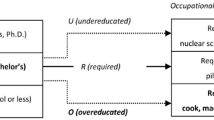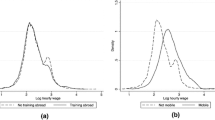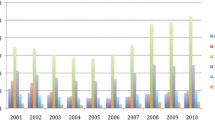Abstract
The literature on human capital, and its positive effects on individuals and regional economies, is now vast. The linkages between human capital and migration have also found a fertile ground in recent years especially in Europe where many studies have focused on interregional migration of graduates and highly skilled individuals. However, the literature on this phenomenon in the USA is less developed. Using the SESTAT database from NSF, this paper aims at contributing to the understanding of inter-state migration behavior of graduates in the USA and its effects on their career outcomes. It builds on the existing literature not only by focusing specifically on the US context, but also incorporating into the empirical model a correction for the possible selection bias that arises from the dual relationship between migration propensity and human capital endowment. Our estimated Mincerian earning equations, corrected for migrant self-selectivity, show that indeed repeat migration is associated with higher average salaries, while late migration is associated with a salary penalty. As for the other control variables, our results are consistent with what has been found in the labor economics literature. Female workers suffer from a salary penalty, while experience, level of education and employer size are all associated with higher average salaries. The labor market also rewards different fields of study differently.

Similar content being viewed by others
Notes
Although, ideally, we would have liked to classify individuals defining migration at county-level, location was only available at state level, so migration is defined as a change of state. This leaves out any interstate migration consideration for which data were not available.
Notice that, as Deb and Trivedi (2006) discuss, the model requires normalization restrictions on the scale of each choice equation and on the variance-covariance parameters. The last condition can be met when \( \delta _{{jk}} = 0~\forall ~j~ \ne k \). Thus if this holds, then each choice is affected by a unique latent factor. Furthermore, in order to normalize the scale of each choice equation, you need to set \( \delta _{{jj}} = 1~\forall ~j \).
To check for the robustness of our results, we also estimated our models for individuals aged 25–40. Results are reported in Table 6. The restriction to younger individuals does not change the results for the large majority of our regressors, and selection and endogeneity are still important factors. However, some of the selection terms do change sign, the “late-migrant” dummy, for instance, is now significant and positive for younger individuals, confirming the finding of Faggian et al. (2007a, (2007b) for the UK.
A complete list is provided in “Appendix” (Table 3).
Data from the World Bank in current prices.
References
Abreu M, Faggian A, McCann P (2015) Migration and inter-industry mobility of UK graduates. J Econ Geogr 15(2):353–385
Abreu M, Faggian A, Comunian R, McCann P (2012) Life is short, art is long: the persistent wage gap between bohemian and non-bohemian graduates. Ann Reg Sci 49:305–321
Abreu M, Koster S, Venhorst VA (2014) Transitions and location choice: analysing the decisions of students and recent graduates. Spat Econ Anal 9(4):349–354
Arcidiacono P, Hotz VJ, Kang S (2012) Modeling college major choices using elicited measures of expectations and counterfactuals. J Econ 166:3–16
Becker GS (1962) Investment in human capital: a theoretic analysis. J Polit Econ 70(5):9–49
Berger MC (1988) Predicted future earnings and choice of college major. Ind Labor Relat Rev 41(3):418–429
Borjas GJ (1987) Self-selection and the earnings of immigrants. Am Econ Rev 77(4):531–553
Borjas GJ, Bronars SG, Trejo SJ (1992) Self-selection and internal migration in the United States. J Urban Econ 32:159–185
Brown C, Medoff J (1989) The employer size-wage effect. J Polit Econ 97(5):1027–1059
Cech E, Pecenco L, Blair-Loy M (2013) Science and technology professions: the status of women and men. In: Center for Research on Gender in the Professions, UC San Diego
Chun H, Lee I (2001) Why do married men earn more: productivity or marriage selection. Econ Inq 39(2):307–319
Comunian R, Faggian A, Li QC (2010) Unrewarded careers in the creative class: the strange case of bohemian graduates. Pap Reg Sci 89(2):389–411
Corcoran J, Faggian A, McCann P (2010) Human capital in remote and rural Australia: the role of graduate migration. Growth Change 41:192–220
Cornelissen T, Dustmann C, Schönberg U (2013) Peer effects in the workplace. IZA Working Papers
DaVanzo J (1983) Repeat migration in the United States: Who moves back and who moves on? Rev Econ Stat 65(4):552–559
DaVanzo J, Morrison P (1981) Return and other sequences of migration in the United States. Demography 18(1):85–101
Deb P, Trivedi PK (2006) Specification and simulated likelihood estimation of a non-normal treatment-outcome model with selection: application to health care utilization. Econ J 9:307–331
Di Cintio M, Grassi E (2013) Internal migration and wages of Italian university graduates. Pap Reg Sci 92(1):119–140
Dotti N, Fratesi U, Lenzi UC, Percoco M (2012) Local labour markets and the interregional mobility of Italian university students. Working Paper, BEST, Politecnico di Milano
Faggian A (2005) Human Capital. In: Caves R (ed) Encyclopaedia of the City. Routledge, New York
Faggian A, Franklin RS (2014) Human capital redistribution in the USA: the migration of the college-bound. Spat Econ Anal 9(4):376–395
Faggian A, McCann P (2009) Universities, agglomerations and graduate human capital mobility. J Econ Soc Geogr 100(2):210–223
Faggian A, Comunian R, Jewell S, Kelly U (2013) Bohemian graduates in the UK: disciplines and location determinants of creative careers. Reg Stud 47(2):183–200
Faggian A, McCann P, Sheppard S (2006) An analysis of ethnic differences in UK graduate migration behaviour. Ann Reg Sci 40:461–471
Faggian A, McCann P, Sheppard S (2007a) Human capital, higher education and graduate migration: an analysis of Scottish and Welsh students. Urban Stud 44(13):2511–2528
Faggian A, McCann P, Sheppard S (2007b) Some evidence that women are more mobile than men: gender differences in U.K. graduate migration behavior. J Reg Sci 47(3):517–539
Franklin R (2003) Migration of the young, single, and college educated: 1995 to 2000. In: Census 2000 Special Reports, CENSR-12, U.S. Census, Washington, DC: U.S. Government Printing Office
Groshen EL (1991) Sources of intra-industry wage dispersion: How much do employers matter? Q J Econ 106(3):869–884
Haapanen M, Tervo H (2006) Migration behaviour and duration of residence spells of graduating students in Finland in 1987–2002. ERSA Conference Papers no. ersa06p379, European Regional Science Association
Harmon C, Oosterbeek H, Walker I (2000) The returns to education a review of evidence, issues and deficiencies in the literature. Centre for the Economics of Education London School of Economics and Political Science, London
Hart RA (1975) Interregional economic migration: some theoretical considerations (part II). J Reg Sci 15(3):289–305
Heckman JJ (1979) Sample selection bias as a specification error. Econometrica 47(1):153–161
Heckman JJ, Sedlacek G (1985) Heterogeneity, aggregation, and market wage functions: an empirical model of self-selection in the labor market. J Polit Econ 93(6):1077–1125
Iammarino S, Marinelli E (2011) Is the grass greener on the other side of the fence? Graduate mobility and job satisfaction in Italy. Environ Plan A 43:2761–2777
Iammarino S, Marinelli E (2015) Education-job (mis)matching and interregional migration: Italian university graduates’ transition to work. Reg Stud 49(5):866–882
Jewell S, Faggian A (2014) Interregional migration ‘Wage Premia’: the case of creative and science and technology graduates in the UK. In: Applied regional growth and innovation models advances in spatial science, pp 197–214
Levy MB, Wadycki WJ (1974) Education and the decision to migrate: an econometric analysis of migration in Venezuela. Econometrica 42(2):377–388
Lucas RE Jr (1988) On the mechanics of economic development. J Monet Econ 22(1):3–42
Marshall R (1974) The economics of racial discrimination: a survey. J Econ Lit 12(3):849–871
Melly B (2005) Public-private sector wage differentials in Germany: evidence from quantile regression. Empir Econ 30:505–520
Mincer J (1958) Investment in human capital and personal income distribution. J Polit Econ 66(4):281–302
Montmarquette C, Cannings K, Mahseredjian S (2002) How do young people choose college major? Econ Educ Rev 21:543–556
Morissette R (1993) Canadian jobs and firm size: Do smaller firms pay less? Can J Econ 26(1):159–174
Murphy-Lejeune E (2002) Student mobility and narrative in Europe: the new strangers. Routledge, London
Pendakur K, Pendakur R (1998) The colour of money: earnings differentials among ethnic groups in Canada. Can J Econ 31(3):518–548
Postel-Vinay F, Turon H (2007) The public pay gap in Britain: small differences that (Don’t?) matter. Econ J 117:1460–1503
Romer PM (1986) Increasing returns and long-run growth. J Polit Econ 94(5):1002–1037
Roy AD (1951) Some thoughts on the distribution of earnings. Oxf Econ Pap 3(2):135–146
Russo G (2010) For love of money. Nature 465(7301):1104–1107
Sabot RH (1987) Internal migration and education. In: Psacharopoulos G (ed) Economics of education research and studies. Pergamon Press, Oxford, pp 196–197
Schultz TW (1961) Investment in human capital. Am Econ Rev 51(1):1–17
Sjaastad LA (1962) The costs and returns of human migration. J Polit Econ 70:80–93
Spence M (1974) Competitive and optimal responses to signals: an analysis of efficiency and distribution. J Econ Theory 7(3):296–332
Storey DJ (2004) Exploring the link, among small firms, between management training and firm performance: a comparison between the UK and other OECD countries. Int J Hum Resour Manag 15(1):112–130
Venhorst VA, Dijk JV, Wissen LV (2010) Do the best graduates leave the peripheral areas of the Netherlands. J Econ Soc Geogr 101(5):521–537
Venhorst V, Dijk JV, Wissen LV (2011) An analysis of trends in spatial mobility of Dutch graduates. Spat Econ Anal 6:57–82
Willis RJ, Rosen S (1979) Education and self-selection. J Polit Econ 87(5):S7–S36
Author information
Authors and Affiliations
Corresponding author
Additional information
We are indebted to the National Science Foundation and specifically the National Center for Science and Engineering Statistics for providing the SESTAT data. They bear no responsibility for the analysis conducted or interpretation of the data. All remaining errors are ours.
Rights and permissions
About this article
Cite this article
Kazakis, P., Faggian, A. Mobility, education and labor market outcomes for U.S. graduates: Is selectivity important?. Ann Reg Sci 59, 731–758 (2017). https://doi.org/10.1007/s00168-016-0773-6
Received:
Accepted:
Published:
Issue Date:
DOI: https://doi.org/10.1007/s00168-016-0773-6




